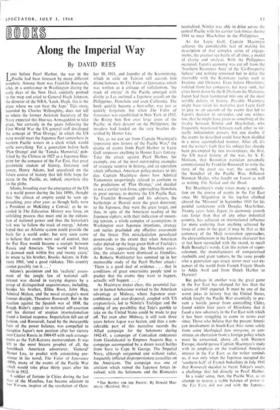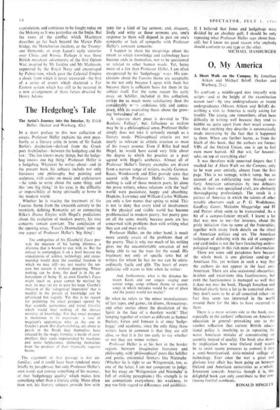Along the Imperial Way By DAVID REES L NG before Pearl
Harbor, the war in the Pacific had been foreseen by many different prophets. Among them was Franklin Roosevelt, who, in a conference in Washington during the early days of the New Deal, suddenly pointed to the map and cried to General Hugh Johnson, the director of the N RA, 'Look, Hugh, this is the place where we can beat the Japs.' This story, recorded by Charles Willoughby, does not tell us where the former Assistant Secretary of the Navy expected this blue-sea Armageddon to take place, but certainly in the years following the First World War the US general staff developed the concept of 'Plan Orange,' in which the US navy would meet the Japanese fleet somewhere in western Pacific waters in a clash which would settle everything. Yet a generation before both 'Plan Orange' and the 'Tanaka Memorial,' pub- lished by the Chinese in 1927 as a Japanese blue- print for the conquest of the Far East, that great pessimistic student of history, literature and power, Henry Adams, had speculated on the future course of history that left little hope for peace in the Pacific, or, indeed, anywhere else on the globe.
Adams, brooding over the emergence of the US as a world power during the late 1890s, thought that 'the climax of empire could be seen ap- proaching, year after year. as though Sulla were a President or McKinley a Consul,' as he re- corded in The Education. History was force, an unfolding process that must end in the exhaus- tion of national power and thus the historian's task was `to follow the track of energy.' Adams hoped that an Atlantic system could provide the basis for a world order, but very soon came to believe that events were out of control, that the Far East would become a cockpit between Russia and America. 'The world will break its damned neck within five and twenty years,' he wrote to his brother, Brooks Adams. in Feb- ruary 1901, 'and a good riddance. This country cannot possibly run it. ...'
Adams's pessimism and his 'realistic' assess- ment of the jungle law of national self- interest was shared in varying degrees by a group of distinguished acquaintances, including, besides his brother, Elihu Root, John Hay, Admiral Mahan, and the naval strategist's most famous disciple, Theodore Roosevelt. But in the reaction against the Spanish war of 1898, the Rough Rider's appeal to national self-assertion and his distrust of utopian internationalism found a limited response. Imperialism fell out of fashion, and Roosevelt, faced by the inescapable facts of the power balance, was compelled to recognise Japan's new position after her victory over Czarist Russia in 1904-05 with such arrange- ments as the Taft-Katsura memorandum. it was left to the most bizarre prophet of all, the hunchback American adventurer, 'General' Homer Lea, to predict with astonishing pre- science in his novel, The Valor of Ignorance 11909), many of the events of the Pacific War Which would take place thirty years after his death in 1912.
A soldier of fortune in China during the last days of the Manchus, Lea became adjutant to S911 Yat-ten, inspirer of the revolution of Octo- ber 10, 1911, and founder of the Kuomintang, which in exile on Taiwan still accords him divine honours. In The Valor of Ignorance, which was written as a critique of isolationism, 'the track of energy' in the Pacific emerged with clarity as Lea outlined a Japanese assault on the Philippines, Honolulu and even California. The book quickly became a best-seller, was just as quickly forgotten, but when The Valor of ignorance was republished in New York in 1942, the Rising Sun flew over large areas of the Pacific; in their descent on the Philippines, the invaders had landed on the very beaches de- scribed by Homer Lea.
Yet, as we can see from Captain Macintyre's impressive new history of the Pacific War,* the drama of events from Pearl Harbor to Leyte Gulf surpasses anything in Homer Lea's fantasy. Take the attack against Pearl Harbor, for example, one of the most outstanding examples of strategic surprise in history, and an operation which influences American policy-makers to this day. Captain Macintyre shows how Admiral Yamamoto unsportingly refused to conform to the predictions of 'Plan Orange,' and decided to use a carrier task-force, approaching Honolulu in great secrecy, to destroy the US Pacific fleet. To Franklin Roosevelt and his advisers, the battleships at Hawaii were the great deterrent; to the Japanese, they were the great target, and thus, in spite of the American reading of the Japanese ciphers, with their indication of mount- ing tension, a whole complex of assumptions in Washington over Japanese intentions, strategy and tactics precluded any effective assessment of the threat. This miscalculation percolated downwards to the extent that when American radar picked up the huge green blob of Fuchida's strike force approaching the Honolulu coast- line, the attackers were dismissed as friendlies. As Roberta Wohlstetter has summed up in her memorable study of the Pearl Harbor attack: `There is a good deal of evidence . . . that in conditions of great uncertainty people tend to predict that the events they want to happen, actually will happen. . .
As Macintyre makes clear, this perennial fac- tor in human behaviour worked to the American advantage at Midway, where Japanese over- confidence and over-dispersal, coupled with US cryptanalysis, led to Nimitz's Trafalgar and the ending of any possibility that Tojo's gamble to take on the United States could be made to pay off. Yet even after Midway, it still took three years before Japan was beaten, and thus a con- siderable part of this narrative records the Allied campaign for the Solomons during 1942-43, a campaign of Conradian endeavour from Guadalcanal to Empress Augusta Bay, a campaign accompanied by a dozen naval battles from Savo to Cape St George. The Imperial Navy, although outgunned and without radar, frequently inflicted disproportionate casualties on the Americans. The campaign was one of attrition which ruined the Japanese forces in- volved; with the Solomons and the Bismarcks * THE BATTLE FOR THE PACIFIC. By Donald Mac- intyre. (Batsford, 30s.)
neutralised, Nimitz was able to drive across the central Pacific with his carrier task-forces during 1944 to meet MacArthur in the Philippines._
As for Leyte Gulf, Captain Macintyre achieves the considerable feat of making his description of that complex series of engage. ments, the greatest sea battle of all time, a model of clarity and analysis. With the Philippines occupied, Japan's economy Was cut off from the 'Southern Resources Area' of the 'Co-Prosperity Sphere' and nothing remained but to delay the inevitable with the Kamikaze tactics used at Iwojima and Okinawa. Even before Hiroshima, isolated from her conquests, her navy sunk, her cities burnt down by the B-29s from the Marianas, Japan had been hammered into one of the most terrible defeats in history. Possibly Macintyre might have taken his narrative past Leyte Gulf to give us an account of the events that led to Japan's decision to surrender, and one wishes, too, that he might have given us something of the rivalry between Nimitz and MacArthur, who frequently negotiated between each other as vir- tually independent powers, but one doubts if the events he described could have been distilled in a more accomplished manner. After all, it's not the writer's fault that his subject has already been pre-empted by two masterpieces, the first, the US naval history of the war, by S. E. Morison, that Bostonian patrician personally commissioned by Franklin Roosevelt to write the story of the great sea war; the second, by the Stendhal of the Pacific War, Rifleman Norman Mailer, who fought on Luzon as well as writing The Naked and the Dead.
Yet Macintyre's study raises many a specula- tion on the course of events in the Far East since Mr Shigemitsu in his top-hat climbed aboard the 'Missouri' in September 1945 for his painful rendezvous with Douglas MacArthur. Twenty years later, Japan, its economic growth rate faster than that of any other industrial country, has achieved an international influence far more enduring than anything achieved by force of arms in the past; it may be that as the centenary of the Meiji restoration approaches, the chrysanthemum in the Japanese character has at last been reconciled with the sword, to recall Ruth Benedict's words. Can this nation of super- salesmen, the manufacturers of computerised steelmills and giant tankers, be the same people who a generation ago struck terror over vast ex- panses of the world from French Frigate Shoals to Addu Atoll and from Dutch Harbor to Darwin?
But perhaps in another way the great game in the Far East has changed far less than the victors of 1945 expected. It must be one of the worst jokes in history that the United States, which fought the Pacific War essentially to pre- vent a hostile power from controlling China, found within four years of Hiroshima that it faced a new adversary in the Far East with which it has been struggling to come to terms ever since. Those who believe that the present Ameri- can involvement in South-East Asia stems solely from some ideological fata morgatza, or con- stitutes an aberration from a foreign policy which must be concerned, above all, with Western Europe, should peruse Captain Macintyre's study with its emphasis on the traditional American interest in the Far East; as the writer reminds us, it was only when the Japanese occupied the 'southern half' of French Indochina in July 1941 that Roosevelt decided to freeze Tokyo's assets, a challenge that led directly to Pearl Harbor.
In a wider sense, then, the Pacific War, as an attempt to restore a stable balance of power ir the Far Fast, did not end with the Japane. capitulation, and continues to be fought today on the Mekong as it was yesterday on theimjin. But the roots of the conflict which Macintyre describes go far back beyond the Marco Polo bridge, the Manchurian incident, or the Twenty- one Demands, or even Japan's early victories over China and Russia. Perhaps it was those British merchant adventurers of the first Opium War, inspired by Mr Jardine and Mr Matheson, supported by the Royal Navy and encouraged by Palmerston, which gave the Celestial Empire a shock from which it never recovered—the first of a series of events which shattered a Far Eastern system which has still to be restored in a new arrangement of those forces descried by Henry Adams.































 Previous page
Previous page